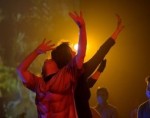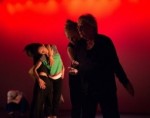
Catharsis: Not Just for Dead Greek Dudes
by Megan Bridge
It’s Saturday night. There is a scene (complete with ‘sters) as I cross the threshold of Christ Church Neighborhood House. Beautiful young people trickle in with beverages, they greet each other and scan the crowd. Simply put, this must be the place to be this weekend: Team Sunshine Performance Corporation’s JapanAmerica Wonderwave.
DJ Chris Powell enters with anonymous bodies. That’s the (lowercase) name of the company: he’s not schlepping random or unidentified people onstage with him. Company members Kate Watson-Wallace and Dorothy Dubrule do a reserved dance that circles with ironic distance around representations of mainstream femininity (piles of clothing, knowing smiles, and plenty of swinging hips). Chris, the aural puppeteer, lays down crystals of popping sound. The dancers’ docile bodies bop. The DJ peacocks. I sit back and let the slick pop music do its affective magic on my brain waves. It’s the perfect opening act.
There’s a break, signs are posted: quick quips with the rhythm of status updates, “Yes, you totally have time for a beer;” “On deck: JapanAmerica Wonderwave.” We chuckle, but having easy information on hand is a comfort. We know what to do. This is fun. The theater darkens.
Enter Ben Camp and Makoto Hirano, their backs to us. Their presence is disarming. They are up there and they are all of us. They fight for the remote (politically, ritualistically—for the right to control the auditory environment; pop-culturally—for the “right” song). After some surfing, rejected tunes serving as an important reminder of exactly where we are NOT, the song clicks in. It’s a song that the teenagers in front of me at the grocery store were talking about. It’s a song that my five year old picked up from his friends at school. You know this song. It’s a pop song. It’s super catchy. We are in the right place. We can relax.
They step on stage. Their movement reminds me of old-fashioned computer games, the ones we X-ers grew up with. Linear. Pixellated. Dot matrix era. A slow-mo skit communicates the daily life of Charlie (played primarily by Makoto, but a lot of role-switching goes on later in this piece). Charlie works in aisle three at Staples: he knows labels. TV is his comfort. A letter arrives in the mail--he’s won a spot on America’s Got Talent.
The handling of time in this work demands media-paced parsing skills. It unfolds not in the theatrical time of slowly developing images, but in the media time of quick shifts. Information is communicated with labels: everything is tagged.
Its creators call JapanAmerica Wonderwave a “disaster response mix-tape...”: the pivotal disaster being the tsunami that devastated Japan on March 11, 2011. Makoto, the work’s lead artist, is Japanese-American, raised in Chicago but with plenty of family across the Pacific. March 11 is also the date that our hero, Charlie, competes on America’s Got Talent. He wins, and goes on to effect massive positive change on the planet (“crime rates down, mid-east peace, joy replaces fear”) through his movement, his YouTube channel, and his “Dance Is the Healing” website.
The tsunami is represented by a trickle of Britta water that gradually fills an edged table-top. Sponge houses float on the surface gracefully and tragically, while a vaguely Bjork-ish pop song plays and dramatic lighting isolates the scene. This clever, tight work of theater that, up until now has been entertaining me and reinforcing my 30-something intellectual, arty subjectivity is now asking—no, demanding--that I feel something. I’m a good audience member: I feel. Makoto leaves the scene and stands with his back to the audience, hands on his head. His narrow waist looks so vulnerable... and in this one gesture I feel viscerally his contemplation of tragedy, of loss, of the fucked-up-ness of life on this planet.
Later on, words, labels, start pouring out of the TV in Charlie’s apartment. Makoto affixes them to the wall, arranging and rearranging, trying to sort the information into some kind of rational, parse-able hierarchy. But how to be rational when confronted by words like these: Ocean Police Hallway Glue Sinkhole Teacher Meltdown 1st grader Parents Emergency blankets Hero Hurricane Ex-lovers Sandy Wave Finger paint Shooter Playground Core...
A lot of people are crying in the house. I purposely seated myself in the back... to witness the response to this tragi-comedy, a massive mirror, a reflection of the barrage of sadness we have to slouch through every day. We hunch our shoulders. We log-in, we keep up. But now here we are, a bunch of warm bodies sitting together, trying to sort it out. “Finger paint,” “glue,” and “1st grader” go in “closet.” Makoto’s filing things. Ex-lovers. Emergency. Hurricane. Sandy. Sandy. Shooter. It’s all about the top story, the awful buzz words that get tucked away in our daily lives. Eventually “1st grader,” “teacher” and “hero” are covered over by the label that reads “shooter.” By the end, everything gets tucked away. More than 15,000 died in the tsunami. But in JapanAmerica Wonderwave, 20 children and six adults on American soil are what remain indelible.
Why? Is it because of the kids? The proximity? How many children died on March 11 and in the wave’s aftermath? Is it because one is a force of nature, and the other pure madness? JapanAmerica Wonderwave opened two days after the Boston Marathon bombings. The tragedies march on.
Fuck the cool scene in Christ Church Neighborhood House, the cute hipsters drinking local craft beer. People are dying. People are being maimed on our TV screens. That’s how I feel it, it’s on my TV screen, my computer screen, my phone. We experience these things through the filter of the media. Duh. That’s the point. Screens in general—good for quick information but also habituating our neural pathways, attenuating our attention to a lower setting, a constant drone. My toddler says “watch this, mama,” but my iPhone screams directly into the wiring of my brain. So, next time she just asks for the phone, instead. This breaks my heart. It breaks me. We are breaking. Broken.
Ben comes back. As performers he and Makoto now are cauterized. Post human. Breathing. Emotional. Gridded. In their final dance, somehow, all is transcended. We see how Charlie could (maybe...could he? I wish he could, I want him to so badly...) heal the world. Finally Makoto (our hero Charlie) settles back in front of his TV. His comfort. Ben (his friend--a stand-in for us?) pours the entire contents of the re-filled Britta pitcher on Makoto’s head. Makoto wipes the water from his eyes as it pours over his face. The simple gesture reminds us: we need this. This ritual, this theater, this liminal space. We need to cry together.
JapanAmerica Wonderwave by Team Sunshine Performance Corporation; opening performance by anonymous bodies II art collective. Christ Church Neighborhood House, May 2-12.
By Megan Bridge
June 1, 2013










